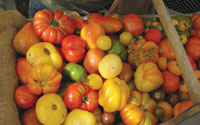
Fruit & Vegetable Report: Back to the Future
By Rosie Lombardi
Food Trends Sustainability consumer perception produce
But as interest in heirlooms grows, savvy food processors may be inspired to adjust their processes to launch tastier, premium-priced lines, says David Cohlmeyer, owner of Cookstown Greens, a Thornton, Ont.-based heirloom farm. “If food processors could start thinking like chefs, you could get a wonderful canned heirloom carrot if you used the right varieties. I think it could be done. Why not? Our great-grandmothers did it.”
Dole Food Co. and Monsanto appear to be taking some first steps in this direction. The companies recently announced a joint five-year project to produce new varieties of spinach, broccoli, cauliflower and lettuce. The objective is to improve the flavour, nutrition and colour of these vegetables. No GMOs will be used in the project, according to Dole spokesperson Marty Ordman.
These companies will likely turn to heirloom varieties to find the characteristics they need, says Wildfong. “The only way to make new kinds of food in conventional horticulture is to dip into the gene pool. Conservation isn’t just for foodies – it has broader implications.” While the status quo may still be comfortable for major food processors, the genetic diversity of food plants will become critical to their future survival, he says. “The double whammy we’ll be dealing with in the next century is expensive transport costs and climate change. Are we still going to be importing food from California, or will we turn to locally grown food? If so, we’ll need to draw upon a strong gene pool so we can adapt to change and breed varieties suited to Canadian conditions. Preserving biodiversity is the best way to ensure we can meet our needs in the future. I don’t know what my grandchildren will enjoy but I want to leave them with choices.”
Print this page